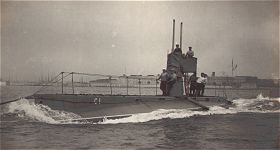|
British Royal Navy`s C class submarine
 As in the `A` and `B` class so was the C class, a progressive development of the Holland type. The A, B and C class followed of entirely Vickers design, with a direct involvement of the Admiralty, and differ in every respect from any other known type of submarine. As in the `A` and `B` class so was the C class, a progressive development of the Holland type. The A, B and C class followed of entirely Vickers design, with a direct involvement of the Admiralty, and differ in every respect from any other known type of submarine.
Some 38 C class were laid down all of which were very similar in main characteristics to the B class although considerable improvements in details took place over the period. C-1to 18 were very similar to the Bs, C-19 to 38 had ballast keel and greatly improved both surface and submerge speed.
Specifications, HMS C-1, C class:
Keel laid down by Vickers Sons & Maxim Ltd in Barrow-in-Furness; launched July 10, 1906
Displacement (srf/sub tons): 287/316
Dimensions (L*B*D feet): 142`2*13`7*8`9
Propulsion: 1*600hp 16-cylinder Vickers petrol engine, 1*300hp electric motors for submergence driving one shafts
Speed (srf/sub knots): 12/7
Range (srf/sub n/miles@knots): 740@12 or 1,300@9/24@7 or 36@4.5
Diving depth (feet): 100
Complement: 2 officers 14 enlisted
Torpedo: 2*18" bow torpedo tube, containing a total of 4 torpedoes
Mines: none
Armament: none
Construction
A total of 38 boats were built during the years 1905-09, most of them by Vickers Sons & Maxim Ltd in Barrow-in-Furness, C-17 to 20 and C-33, 34 were built by Chatham Royal Dockyard. The class retained the spindle hull form as in former classes.
Back to History Index
|